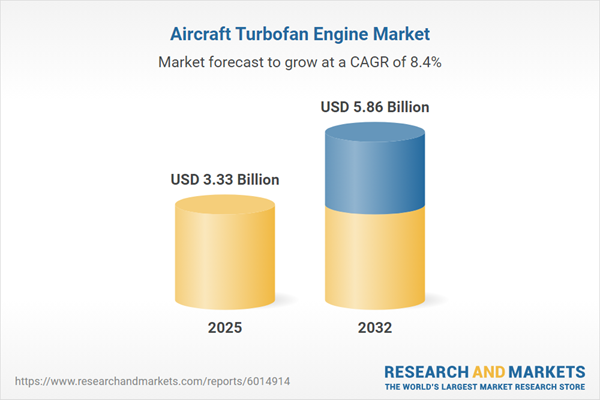Speak directly to the analyst to clarify any post sales queries you may have.
Senior aviation executives face an evolving landscape as propulsion innovation accelerates, operational needs shift, and new regulations take hold. Strategic decisions in the aircraft turbofan engine market demand current, actionable intelligence to meet performance, compliance, and sustainability priorities.
Market Snapshot: Aircraft Turbofan Engine Market
The global aircraft turbofan engine market is valued at USD 3.08 billion in 2024, with projections reaching USD 3.33 billion in 2025 and USD 5.86 billion by 2032, reflecting a vigorous CAGR of 8.37%. This growth stems from surging passenger and cargo volumes, advanced engine architectures focusing on fuel efficiency, and firm sustainability targets in the commercial and military aviation sectors. The shift toward high-bypass systems, integration of digital propulsion technologies, and fast adaptation to environmental regulations are prompting industry leaders to review investment strategies and prioritize next-generation solutions.
Scope & Segmentation
- Application: Analysis spans commercial aircraft, business jets, military, and regional jets. Each aircraft type requires distinctive propulsion investments that align with duty cycles and specialized mission demands.
- Thrust Range: Segment includes turbofan engines below 20 kN, 20–50 kN, 50–100 kN, and above 100 kN, ensuring compatibility with both legacy and cutting-edge airframes.
- Bypass Ratio: Encompasses low, medium, and high bypass variants. Segment differentiation is important for aligning operational strategies around fuel savings, noise mitigation, and emission control targets.
- End User: Strategic needs of MRO providers, OEMs, and aftermarket specialists are assessed, with a focus on uptime, reliability, and lifecycle service enhancement.
- Engine Cycle: Covers both two-shaft and three-shaft architectures, supporting fleet managers in balancing efficiency, compatibility, and network integration requirements.
- Drive Configuration: Reviews direct drive and geared turbofan innovations for compatibility with changing fleet mixes and performance standards across geographies.
- Geographic Coverage: Includes Americas, EMEA, and Asia-Pacific markets, paying close attention to regional dynamics in the UK, Germany, UAE, South Africa, China, India, Japan, Australia, and Singapore, each influencing investment pace and technology deployment.
- Leading Companies Profiled: Examines CFM International, Pratt & Whitney, Rolls-Royce plc, International Aero Engines AG, IHI Corporation, MTU Aero Engines AG, PowerJet SA, Engine Alliance LLC, United Engine Corporation, and JSC Aviadvigatel for strategic insight into propulsion innovation and industry shifts.
Key Takeaways for Decision-Makers
- Propulsion system investments that anticipate or align with sustainability mandates strengthen regulatory positions and fleet adaptability in both commercial and defense aviation.
- Engine manufacturers provide custom solutions for diverse operator profiles—helping expand fleet versatility and enable swift mission reconfiguration as operational needs shift.
- Use of additive manufacturing and advanced materials is improving durability, streamlining parts production, and supporting optimized engine lifecycle management.
- Adoption of digital maintenance solutions—including predictive analytics—enables proactive detection of issues, better cost management, and improved aircraft availability.
- Regional opportunities and challenges remain distinct: North American airlines focus on modernization, EMEA emphasizes regulatory adaptation, while Asia-Pacific invests in rapid expansion and the adoption of newer technologies.
- Collaboration between OEMs, digital technology providers, and logistics partners is strengthening supply chain agility—supporting continuity despite evolving global risks and compliance landscapes.
Impact of U.S. 2025 Tariffs on Market Dynamics
Forthcoming U.S. tariffs on turbofan engine systems will influence procurement and production strategies throughout North America. Industry stakeholders are responding by evaluating increased domestic manufacturing, diversifying supply chains, and implementing flexible modular production models to minimize risk exposure and support operating cost stability under new trade conditions.
Methodology & Data Sources
This research is built on direct interviews with aviation executives, supply chain specialists, and regulatory professionals. Analysis incorporates technical reviews and regulatory documents, with data triangulated and validated for accuracy and executive relevance.
Why This Report Matters
- Delivers actionable insight on propulsion technologies, digital transformation, and regional fleet trends for effective long-range investment planning.
- Supports continuous management of compliance and risk by clarifying sector shifts and operational imperatives during ongoing aviation market transformation.
- Equips decision-makers to identify and respond to shifts in technology, operations, and the wider competitive landscape with confidence.
Conclusion
Senior aviation leaders can rely on this analysis for essential, forward-focused intelligence, supporting sound decision-making as market and regulatory factors reshape the aircraft turbofan engine sector.
Additional Product Information:
- Purchase of this report includes 1 year online access with quarterly updates.
- This report can be updated on request. Please contact our Customer Experience team using the Ask a Question widget on our website.
Table of Contents
3. Executive Summary
4. Market Overview
7. Cumulative Impact of Artificial Intelligence 2025
Companies Mentioned
The companies profiled in this Aircraft Turbofan Engine market report include:- CFM International
- Pratt & Whitney
- Rolls-Royce PLC
- International Aero Engines AG
- IHI Corporation
- MTU Aero Engines AG
- PowerJet SA
- Engine Alliance, LLC
- United Engine Corporation
- JSC Aviadvigatel
Table Information
| Report Attribute | Details |
|---|---|
| No. of Pages | 199 |
| Published | November 2025 |
| Forecast Period | 2025 - 2032 |
| Estimated Market Value ( USD | $ 3.33 Billion |
| Forecasted Market Value ( USD | $ 5.86 Billion |
| Compound Annual Growth Rate | 8.3% |
| Regions Covered | Global |
| No. of Companies Mentioned | 11 |









